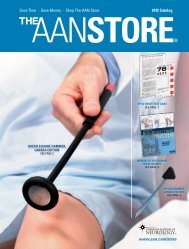weakness: practical guide for family physicians - American Academy ...
weakness: practical guide for family physicians - American Academy ...
weakness: practical guide for family physicians - American Academy ...
You also want an ePaper? Increase the reach of your titles
YUMPU automatically turns print PDFs into web optimized ePapers that Google loves.
On day 4 after admission, nursing service in<strong>for</strong>med the admitting physician that the<br />
patient could no longer move his legs to cooperate with bathing. Repeat examination disclosed<br />
that the patient had flaccid paraplegia of both lower extremities. Neurological consultation<br />
confirmed flaccid lower extremity paraplegia, a sensory level at T-10 and diminished rectal<br />
sphincter tone. Beevor’s sign, was present (upward motion of the umbilicus with neck flexion<br />
while lying supine, caused by <strong>weakness</strong> of abdominal muscles below T-10).<br />
An emergency MRI scan showed some lysis of the T-10 vertebral body with a posterior<br />
tumor mass compressing the conus medullaris and distal spinal cord. Emergency radiation<br />
therapy to the area was started. Six months later the patient had some return of antigravity leg<br />
movement, but was unable to ambulate independently.<br />
Discussion. The above case illustrates how spinal cord lesions can progress, subacutely,<br />
to full paraplegia even when the patient is in a setting where he/she is observed. Once the patient<br />
is on bed rest, progressive leg <strong>weakness</strong> is harder to detect, by medical staff or the patient.<br />
Numerous early warning signs could have alerted the physician to the presence of an early<br />
myelopathy in this patient:<br />
Multiple spine compression fractures; and an abnormal bone scan with a known<br />
malignancy (prostate carcinoma), that is known <strong>for</strong> bone metastasis.<br />
Increased frequency of falls most likely due to progressive leg <strong>weakness</strong>.<br />
Development of spine pain as part of the current symptomatology, secondary to<br />
metastases and compression fractures.<br />
Overflow urinary incontinence, with a large residual volume on catheterization, due to<br />
evolving <strong>weakness</strong> of the bladder detrusor muscles secondary to sacral outflow<br />
interruption.<br />
Daily neurological examination would to have led to earlier detection of evolving leg<br />
<strong>weakness</strong>, a rising sensory level, and the development of lower abdominal wall <strong>weakness</strong><br />
(Beevor’s sign). The <strong>weakness</strong> would have had the characteristic upper motor neuron<br />
distribution with extensor muscle groups being stronger than the corresponding flexors.<br />
(Gluteus maximus stronger than iliopsoas, quadriceps stronger than hamstrings and<br />
gastocnemius stronger than anterior tibial, posterior tibial stronger than peronei. It is<br />
this distribution of <strong>weakness</strong> that produces the classic leg posture in upper motor neuron<br />
<strong>weakness</strong>; leg extended at the hip and knee with the foot pointed down and inverted).<br />
The importance of this case lies in the fact that, once paraplegia develops, and lasts <strong>for</strong> up<br />
to 24 hours, surgical or radiation intervention may not be as beneficial in terms of restoration of<br />
normal neurological function. Any spinal cord lesion, once suspected should be monitored<br />
closely <strong>for</strong> progression, while the work-up proceeds to determine the cause, and thus the<br />
treatment of the pathological process.<br />
129








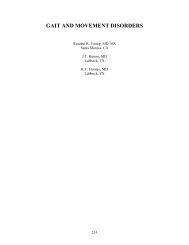
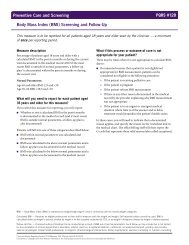

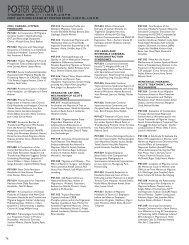
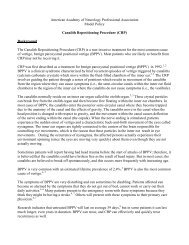
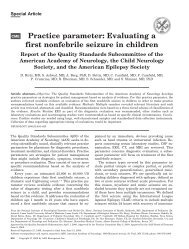

![[Click here and type date] - American Academy of Neurology](https://img.yumpu.com/8582972/1/190x245/click-here-and-type-date-american-academy-of-neurology.jpg?quality=85)
